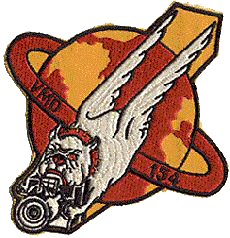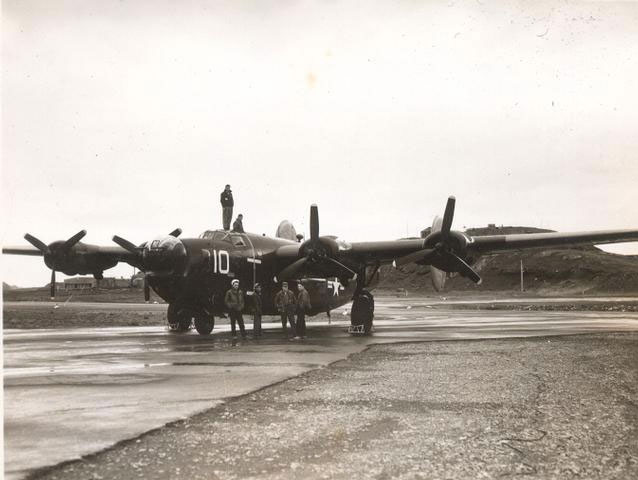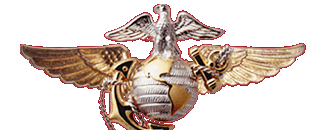MCARA Units > VMD-1/VMD-154 (1942-1945)
Marine Photographic Squadron 154
(VMD-154) History
VMD-154 was originally commissioned as VMD-2 at San Diego on 1 April, 1942 with Maj Elliot Bard as CO. VMD-2 along with VMD-1 its sister squadron found itself in organizational disarray as it had a photo reconnaissance mission but no suitable aircraft available. With the Japanese expansion in the South Pacific as yet unchecked the need for long range reconnaissance capability to support future amphibious operations was critically apparent. In May, a decision was made to equip VMO-251 which had stood up in San Diego in December with modified F4F-3 Wildcats and deploy it as a stop gap capability, although those aircraft did not have the range that was going to be needed.
 In July the Navy reached an agreement with the Army to share the production of the long range Consolidated B-24D bombers which they would in turn share with the Marine Corps. The B-24D redesignated PBY4-1s by the Navy was seen as the answer for long range photo reconnaissance. In August with the Guadalcanal operation underway but still in doubt, both VMDs began intensive training in the new aircraft but first the squadrons were redesignated as VMD-154 and 254. By the end of September, VMD-254 was deemed better qualified for rapid deployment and the then Lt Col Bard was given command of that unit now designated VMD-154 and directed to deploy to the South Pacific beginning in October. He led a forward echelon of two aircraft (out of 8 assigned) first to Hawaii in mid October for some additional equipment and training then onward to Espritu Santo island to relieve VMO-251 by mid November. The main body of the squadron left in early December on two transports but did not arrive until the end of December. In January, the squadron had a full complement of 8 aircraft with 29 officers and 405 enlisted.
In July the Navy reached an agreement with the Army to share the production of the long range Consolidated B-24D bombers which they would in turn share with the Marine Corps. The B-24D redesignated PBY4-1s by the Navy was seen as the answer for long range photo reconnaissance. In August with the Guadalcanal operation underway but still in doubt, both VMDs began intensive training in the new aircraft but first the squadrons were redesignated as VMD-154 and 254. By the end of September, VMD-254 was deemed better qualified for rapid deployment and the then Lt Col Bard was given command of that unit now designated VMD-154 and directed to deploy to the South Pacific beginning in October. He led a forward echelon of two aircraft (out of 8 assigned) first to Hawaii in mid October for some additional equipment and training then onward to Espritu Santo island to relieve VMO-251 by mid November. The main body of the squadron left in early December on two transports but did not arrive until the end of December. In January, the squadron had a full complement of 8 aircraft with 29 officers and 405 enlisted.
 The forward echelon got right into its new role within days of arriving at Espiritu Santo which was about 300 miles South of Guadalcanal. The Japanese, having conceded Guadalcanal to the Marines at that point although fighting continued, were intent on building a new airfield at Munda, New Georgia to enable sustained attacks against U.S. forces. On 4 December, Lt. Col Bard flew a mission over Munda that confirmed the new airfield and it was quickly destroyed by U.S. bombers. A routine for sustained operations evolved with aircraft being deployed forward to Guadalcanal for 2 weeks at a time to support reconnaissance of Japanese activity up the island chain. Photo processing and interpretation support was provided by the Navy lab aboard the USS Curtiss at anchor at Guadalcanal. On 29 December, one of the squadron’s aircraft was jumped by several Japanese fighters but was able to fend them off with its guns with two kills. The pilot,1/Lt Gray, was hit and the aircraft damaged, but the crew was able to recover at Guadalcanal. In February, the squadron lost its only aircraft and crew in an accident taking off from Espiritu Santo.
The forward echelon got right into its new role within days of arriving at Espiritu Santo which was about 300 miles South of Guadalcanal. The Japanese, having conceded Guadalcanal to the Marines at that point although fighting continued, were intent on building a new airfield at Munda, New Georgia to enable sustained attacks against U.S. forces. On 4 December, Lt. Col Bard flew a mission over Munda that confirmed the new airfield and it was quickly destroyed by U.S. bombers. A routine for sustained operations evolved with aircraft being deployed forward to Guadalcanal for 2 weeks at a time to support reconnaissance of Japanese activity up the island chain. Photo processing and interpretation support was provided by the Navy lab aboard the USS Curtiss at anchor at Guadalcanal. On 29 December, one of the squadron’s aircraft was jumped by several Japanese fighters but was able to fend them off with its guns with two kills. The pilot,1/Lt Gray, was hit and the aircraft damaged, but the crew was able to recover at Guadalcanal. In February, the squadron lost its only aircraft and crew in an accident taking off from Espiritu Santo.
The squadron flew over 300 successful missions in support of Navy and Marine Corps operations in the South Pacific theater before beginning to rotate back to CONUS in November 1943. After turning over its aircraft on the West Coast, the squadron regrouped in 1944 at Kinston, near Cherry Point in North Carolina and transitioned to the F6F-3P Hell Cat aircraft but with the wars end in August, 1945 the squadron was decommissioned on 10 September.
(Write up provided by Col H. Wayne Whitten based on a volume of information available on the VMD-154 Association website)


